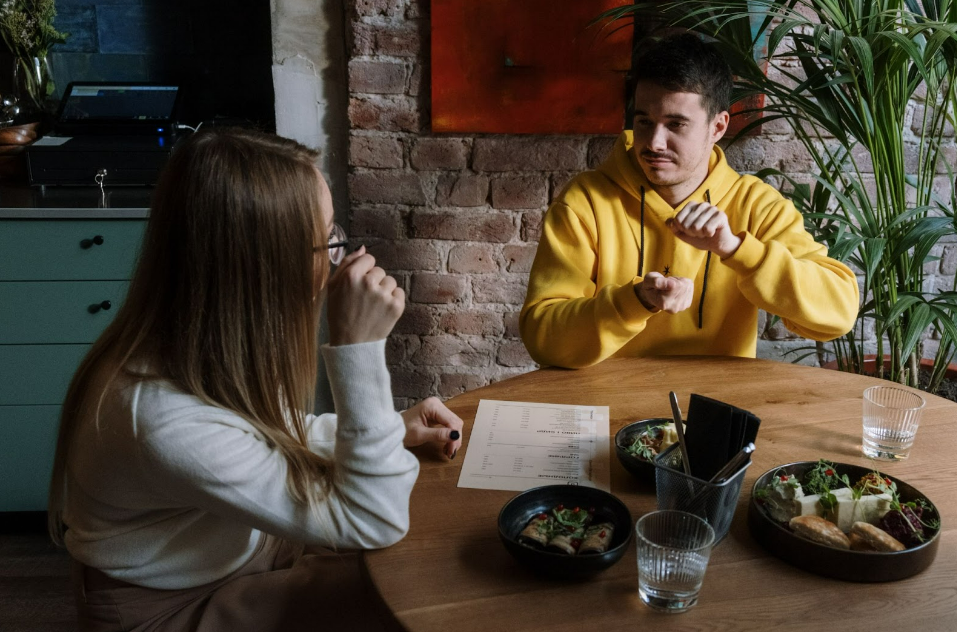Deaf Culture can be defined as the customs, arts, social institutions, and achievements within the Deaf community. Deaf culture grew from a network of Deaf and hard of hearing people attending residential and day schools for the Deaf and growing a network of individuals after graduation. There are four components of Deaf culture but using American Sign Language (ASL) is the cornerstone. The Americans with Disabilities Act (ADA) allows access to sign language interpreters so that the preferred method of communication within Deaf culture can be communicated between hearing and Deaf groups.
Four Components of Deaf Culture
As stated before, there are four components of Deaf Culture: language, behavior norms, values, and traditions. The language used between deaf individuals and within deaf culture is ASL. Behavior norms for Deaf culture include using eye contact, touch, and physical proximity to help aid communication; these often vary greatly from mainstream American cultural behavior norms. For example, it is acceptable to touch a deaf stranger to gain their attention, something that would be considered socially inappropriate in American culture. Values and traditions for an individual that identifies as a member of the deaf community include attending schools and after school programs that are solely for Deaf or hard of hearing individuals.
Five Hallmarks of Deaf Culture
Like any other culture, Deaf culture defines primary cultural hallmarks as language, heritage, customs, arts, and family. ASL is used as the primary language and mode of communication for Deaf culture. ASL and Deaf culture go hand in hand; ASL is fundamental in developing a Deaf person’s linguistic and communicative abilities as well as helping them grow socially through interactions where ASL is the sole method of communication.
Deaf heritage is a major component of the culture. The first US deaf school opened in 1817 and since then nearly 100 deaf schools have opened. For higher education, Gallaudet University, which opened in 1864, is a private university for deaf and hard of hearing students. The implementation of these schools laid the foundation for deaf culture as it allowed deaf individuals to come together and build upon their shared beliefs, traditions, and customs.
Some of the customs shared by deaf culture include the belief that Deafness is normal. Deafness is not seen as a disability and many deaf people find the label offensive. Deafness that runs in families is something to be celebrated.
Deaf Culture Art is a term coined by a group of artists in 1989, during the first Deaf Way festival. While art is a medium that can be communicated visually and doesn’t require the use of auditory communication, deaf artists have built a strong network to bring the Deaf community together. Many of the topics displayed through artists who identify with Deaf culture deal with the shared feelings of the Deaf community, whether positive or negative.
Family is critical for an individual to develop strong connections to Deaf culture. Less than 10% of deaf children are born to deaf parents, meaning that for a Deaf individual to find connection to Deaf culture, families must play an active role in developing that individual’s strong deaf identity. For children born to Deaf parents, Deaf culture is ingrained from birth, for those born to hearing parents, it will take more time. But either way, it is important that a Deaf person has access to others with shared language, beliefs, culture, and arts so they develop a positive identity around their deafness.

How ADA Laws Help Deaf Culture
Because Deaf culture is so tight knit, often outsiders don’t fully understand the components or hallmarks of the culture. This can lead to misinterpretations and miscommunications. It can also create problems for deaf individuals who don’t have full access to the deaf culture. This lack of access doesn’t allow them to grow and network within Deaf culture and they tend to identify more with hearing individuals, which isn’t a bad thing, but there are so many benefits for Deaf individuals to have strong positive connections to Deaf culture. ADA laws help both Deaf and hard of hearing individuals connect to mainstream culture through the use of equal access to education, employment, local and state government, transportation, and telecommunications.
The biggest way ADA laws level the playing field for Deaf individuals is to make sure that all deaf individuals have access to a sign language interpreter. Sign language is the communication method for members of Deaf culture, and without sign language interpreters, Deaf community members may feel marginalized when interacting with the public. In fact, ADA Titles I through IV include specific stances on the level of access Deaf individuals should receive. These stances allow Deaf individuals the same equal access to quality education-whether mainstream schools or Deaf only day or residential schools, protection against employment discrimination and allowances for accommodations, the same caliber of healthcare as hearing individuals, and protection against discrimination from law enforcement individuals due to communication. All these stances state that if requested, a quality sign language interpreter should be used. In telecommunications, sign language interpreters are utilized for local and state government announcements and closed captioning is on all entertainment or news programming. The ADA’s ruling body—the Department of Justice–works in conjunction with multiple federal agencies including the Equal Employment Opportunity Commission and the Federal Communication Commission to make sure all components of the ADA are being followed.
Conclusion
Deaf culture is a beautiful and storied culture full of amazing individuals and the destigmatizing of deafness. The ADA helps to provide protection of Deaf culture by making sure that Deaf individuals do not feel discriminated upon and provide equal protections to deaf individuals. A major component of this is access to a qualified sign language interpreter. If you ever need a qualified sign language interpreter, reach out to Unspoken Language Services, a professional sign language interpreting service that is helping to bridge gaps and provide an inclusive and accessible environment for all.

